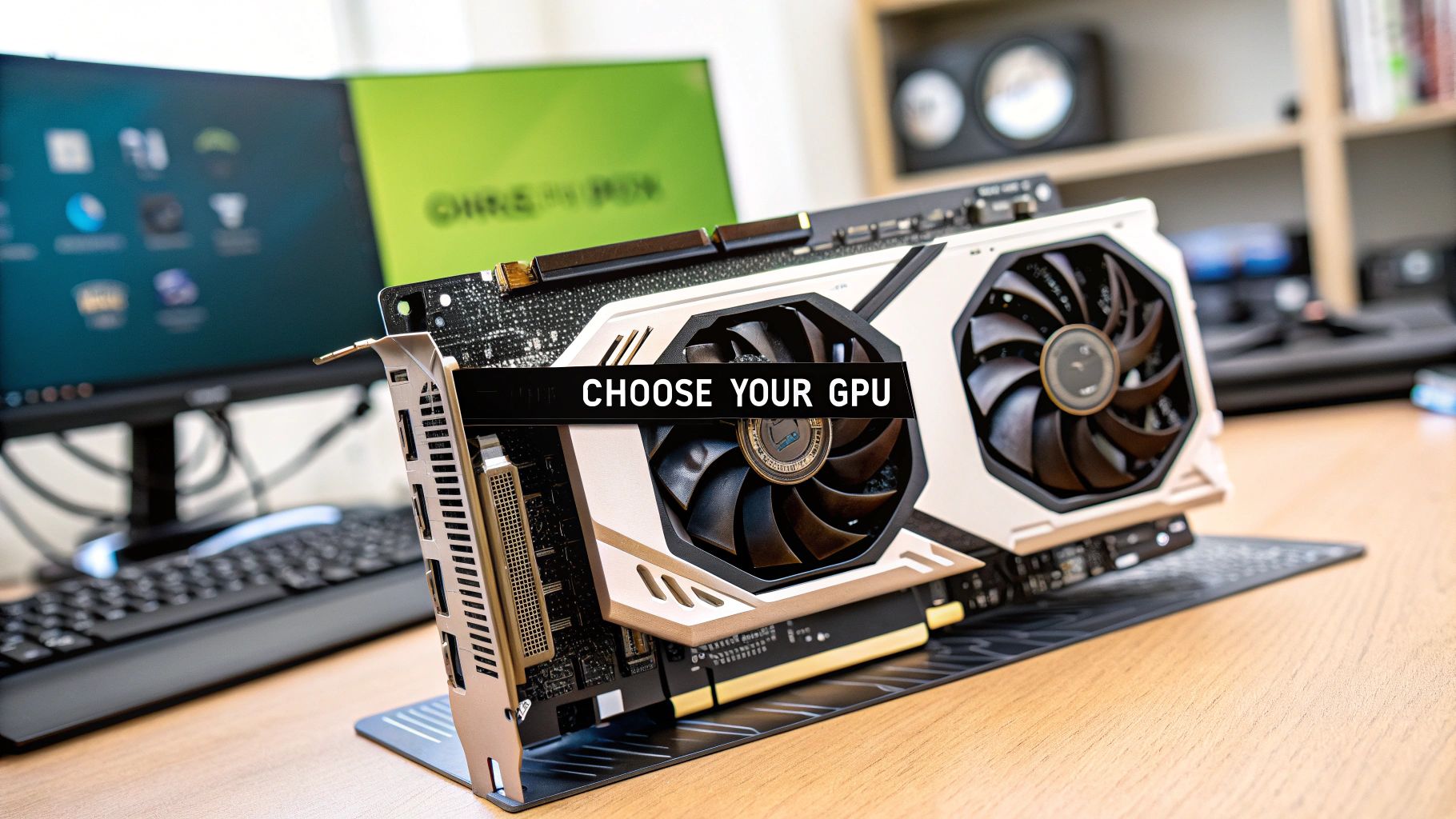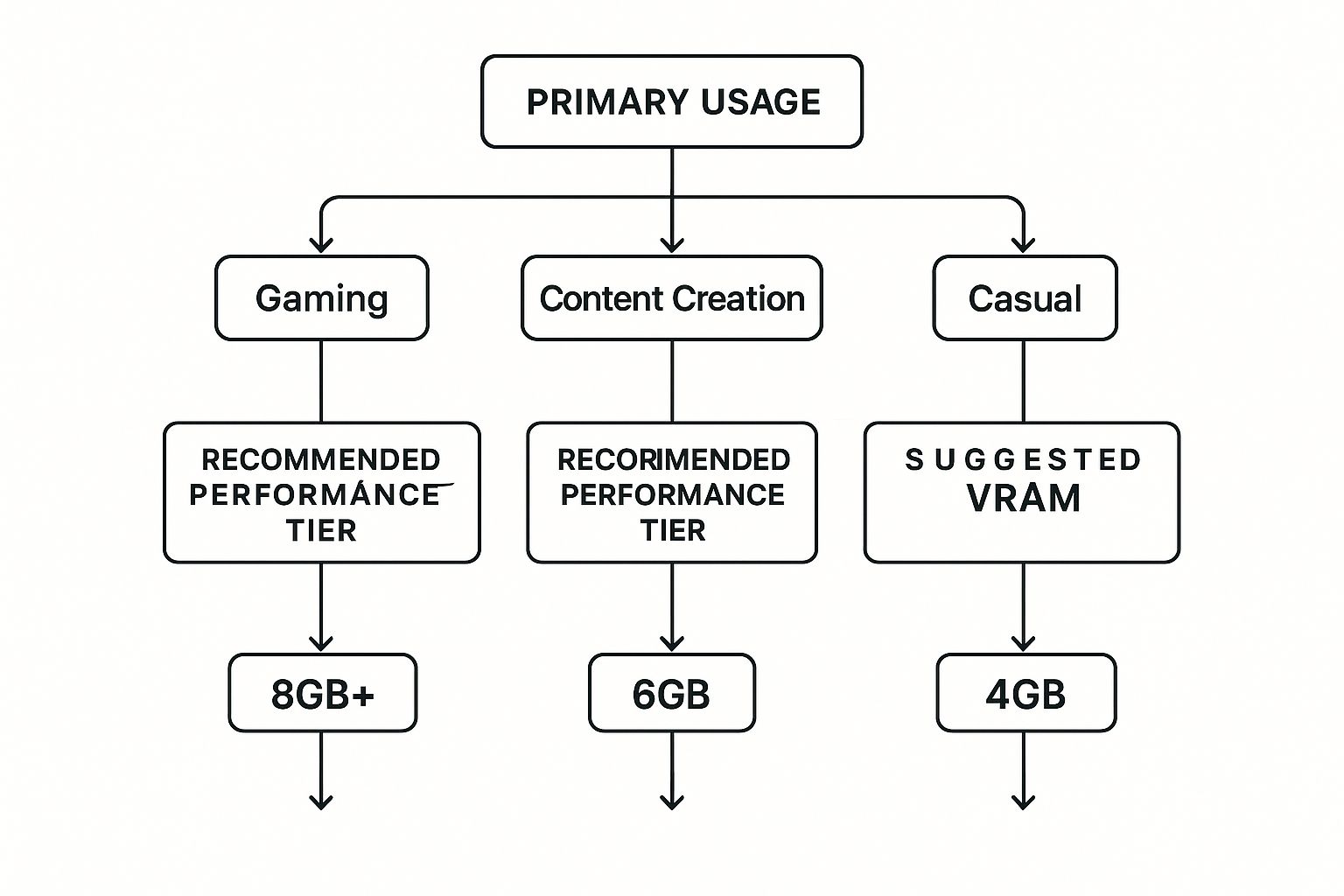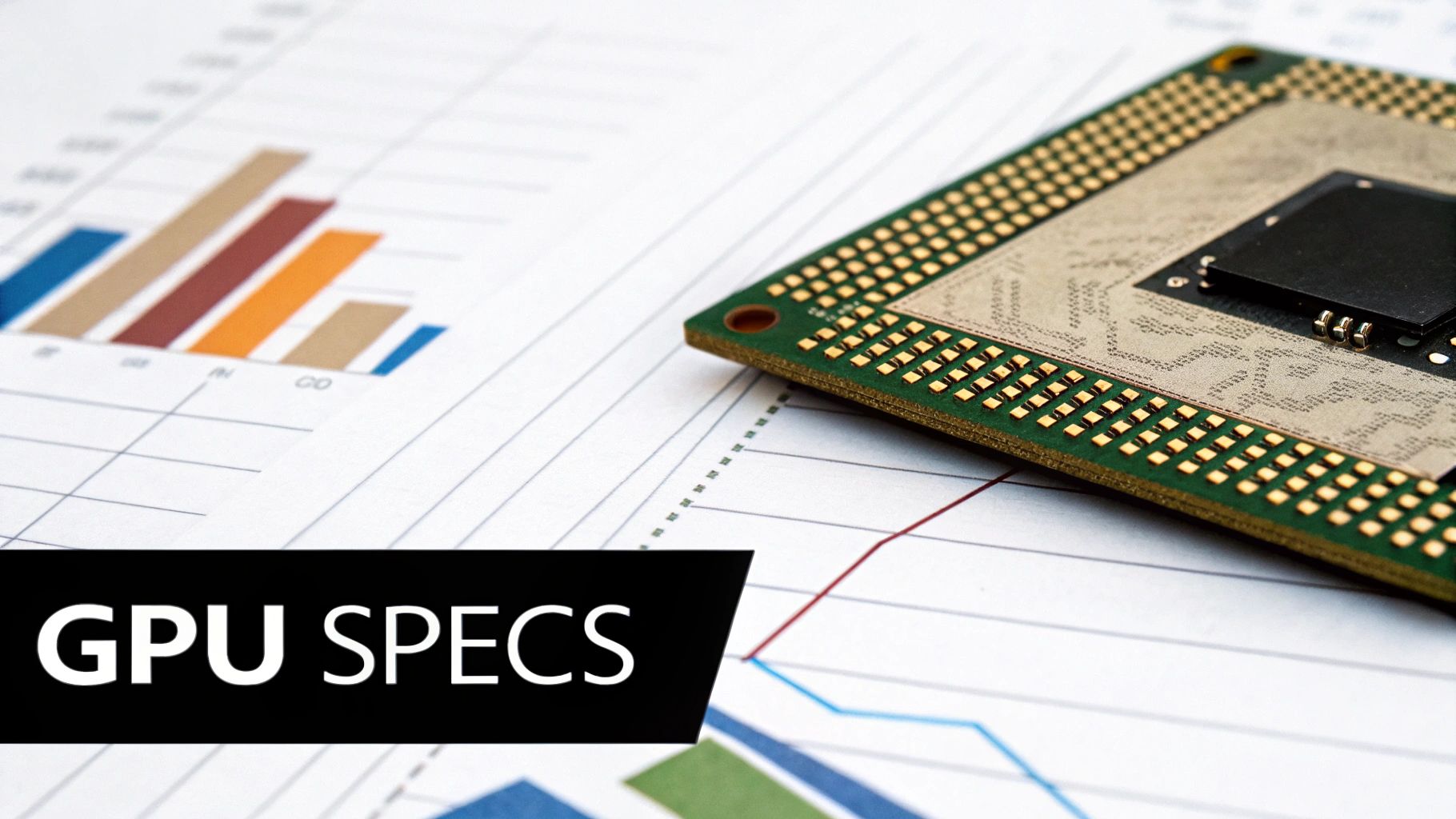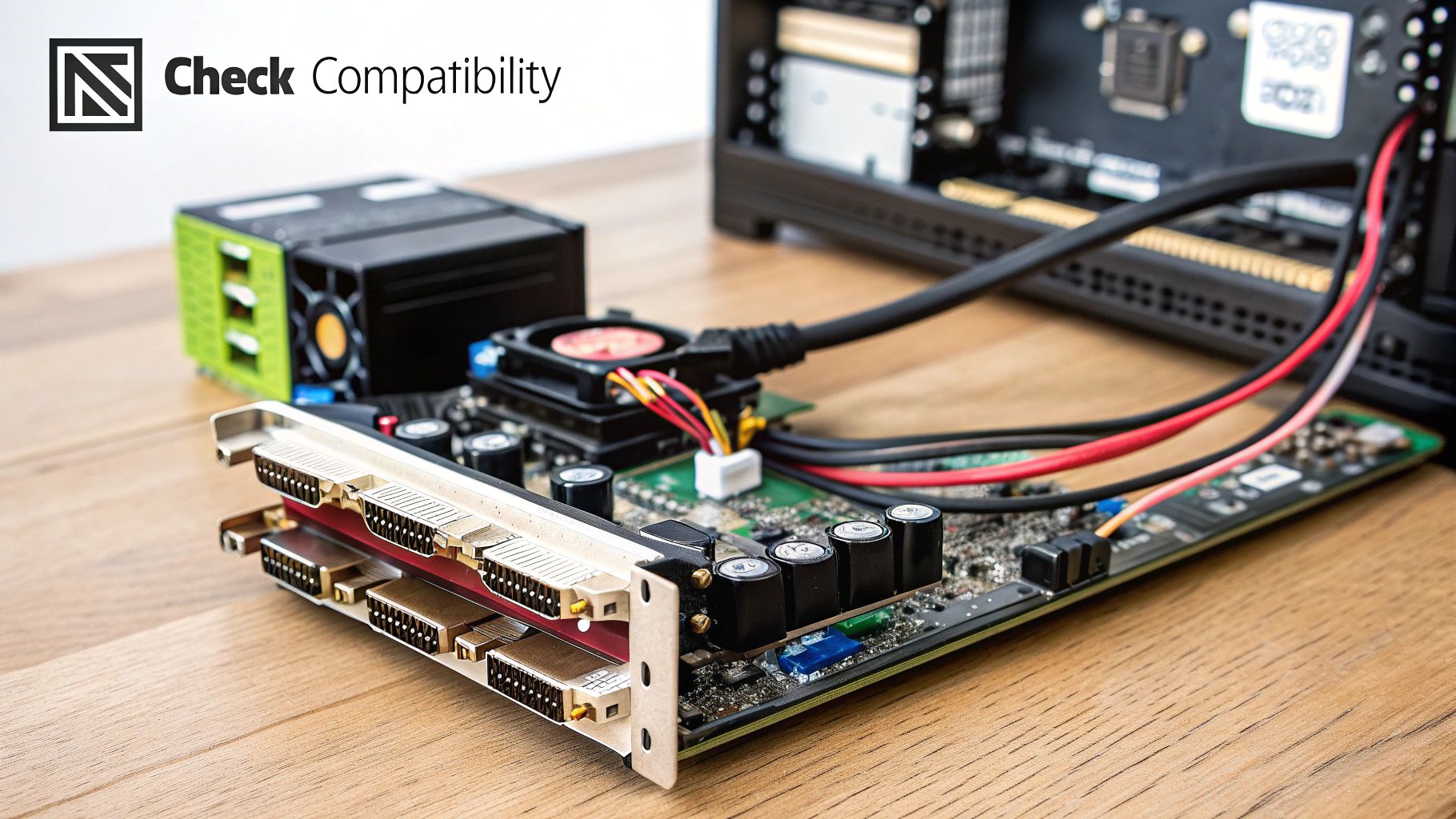How to Choose a Graphics Card: UK Buyer’s Guide
How to Choose a Graphics Card: UK Buyer’s Guide

Choosing the right graphics card isn't about chasing the biggest numbers or the highest price tag. It's about a simple, honest match: finding the card that fits what you actually do with your PC and what you can afford.
For gamers, this means zeroing in on a GPU that delivers the frame rates you crave at your chosen resolution. For creative pros, it’s all about VRAM and processing grunt for silky-smooth rendering. If you figure out your needs first, you'll sidestep the trap of paying for power you’ll never touch.
What Do You Really Need a GPU For?
Before you dive headfirst into a sea of tech specs and slick marketing, take a moment. The most important thing you can do is figure out what your PC's main job will be. The "best" graphics card isn't the most powerful one on the shelf; it's the one that’s a perfect partner for your daily tasks. Get this part right, and you're already halfway to a smart purchase.
It's so easy to get wowed by flashy benchmark scores. But let’s be real—a top-tier GPU is massive overkill if you’re just playing esports titles at 1080p. On the flip side, trying to save a few quid on a card for a 4K video editing rig is a recipe for frustration and hours of wasted time. A little self-reflection here saves a lot of buyer's remorse later.
What’s Your Main Gig?
Let's cut to the chase and figure out what kind of user you are. Everyone's needs are different, so finding your category is key.
- Hardcore Gamer: Your decision hangs on two things: resolution and refresh rate. Getting a buttery-smooth 1080p experience is a different ball game to powering an immersive 4K setup with all the ray-tracing bells and whistles. The games you play matter, too. A fast-paced shooter needs sky-high frame rates, while you can get away with less in a story-driven RPG.
- Content Creator: If you’re a video editor, 3D artist, or graphic designer, your GPU is your workhorse. It’s a co-processor that slashes through rendering and processing times. For you, VRAM (video memory) and specific hardware acceleration features often trump raw gaming performance.
- Everyday User: Is your PC mostly for browsing, streaming Netflix, and handling emails? You probably don't need a beefy, dedicated graphics card at all. Modern CPUs with integrated graphics are more than capable of handling these tasks, saving you a good chunk of cash.

To make it even clearer, here’s a quick-reference table to help you match your main activity with the right class of GPU.
GPU Use Case and Recommended Tier
This table should give you a solid starting point, translating your needs into a tangible hardware category.
Don’t Forget the Bigger Picture
Your choice of GPU has a ripple effect across your entire system. A beastly graphics card needs a CPU that can keep up to avoid a performance bottleneck, where your processor holds your new GPU back. It also needs a solid power supply unit (PSU) with enough wattage and proper case cooling to keep things running smoothly and safely.
Even your home internet can play a part, especially if you're a competitive online gamer. For the absolute lowest latency, check out our guide comparing fiber vs cable internet to make sure your connection isn't the weak link in your shiny new setup.
Forget the marketing hype for a second. By honestly defining what you need your PC to do, you can make a smart decision that balances performance, features, and your budget. This way, every pound you spend directly improves your experience.
Ultimately, understanding your own needs is the best way to start your search. It changes the question from a confusing "Which card is the best?" to a much simpler "Which card is best for me?". This focus lets you cut through the noise and hone in on the models that will actually deliver what you need.
Decoding GPU Specs That Actually Matter

A graphics card's spec sheet can look like a wall of intimidating technical jargon. Manufacturers love throwing around big numbers and confusing acronyms, but honestly, only a handful of these specs truly dictate how your games will run or how fast your creative projects will render.
Learning to see past the marketing noise is the most important skill you can develop in your hunt for the perfect GPU. It's what allows you to properly weigh up cards from NVIDIA and AMD on their actual merits, not just brand loyalty. Once you get a grip on these core components, you'll be able to make a choice you’re confident in, knowing you've squeezed every last drop of performance out of your budget.
The Brains of the Operation: GPU Chipset and Cores
At the heart of every graphics card is the GPU (Graphics Processing Unit) itself—the chip that does all the heavy lifting. The two main players here are NVIDIA, with its GeForce line, and AMD, with its Radeon series. But the brand name is just the beginning; the specific architecture and core counts are what really define a card's power.
Think of the architecture as the generation of the technology. A newer architecture, like NVIDIA's "Ada Lovelace" or AMD's "RDNA 3," is almost always more efficient and packs more advanced features than an older one, even if the core counts look similar on paper.
Within that architecture, you have a few different types of cores to look out for:
- CUDA Cores (NVIDIA) / Stream Processors (AMD): These are the general workhorses. Put simply, more of these usually means more raw power for tasks like rendering frames in a game.
- RT Cores (Ray Tracing Cores): This is specialised hardware you’ll find on modern NVIDIA and AMD cards. Their whole job is to handle the intense maths needed for ultra-realistic lighting and reflections, a feature known as ray tracing. A card with more, or more advanced, RT Cores will give you much better frame rates when you flick that setting on.
- Tensor Cores (NVIDIA) / AI Accelerators (AMD): This is another bit of specialised hardware, built for AI and machine learning. For us gamers, their most important job is powering AI upscaling tech like NVIDIA's DLSS (Deep Learning Super Sampling) and AMD's FSR (FidelityFX Super Resolution).
These AI-powered upscaling features are absolute game-changers. They work by rendering your game at a lower resolution and then using AI to intelligently scale it up to your monitor's native resolution. The result? A massive performance boost, often with very little noticeable drop in visual quality. Prioritising a card with strong AI capabilities is a genuinely smart move to future-proof your rig.
VRAM: How Much Memory Do You Really Need?
VRAM, or Video RAM, is the super-fast memory that lives directly on your graphics card. It acts as a temporary holding pen for all the game textures, models, and other bits and pieces the GPU needs to access in a flash. If a game needs more VRAM than your card has, it's forced to pull that data from your system's much slower RAM, which is what causes that awful stuttering and choppy performance.
The amount you need is tied directly to your gaming resolution and the settings you want to use. The principles are the same even if you're choosing a GPU for a laptop, though the components are integrated differently. For more on that, check out our guide on how to choose the right laptop.
Here’s a quick-and-dirty breakdown of what to aim for:
- 1080p Gaming: 8GB is the sweet spot right now. It gives you plenty of headroom for high-quality textures in most modern games without forcing you to spend a fortune.
- 1440p Gaming: You really want to be looking at 12GB. As the resolution goes up, so do the texture sizes, and 12GB will keep things running smoothly with the settings cranked up.
- 4K Gaming & Creative Work: 16GB or more is pretty much essential. 4K textures are huge, and demanding creative work like 4K video editing can gobble up VRAM like there’s no tomorrow.
Beyond just the amount, the type of memory matters a bit, too. You'll see terms like GDDR6 and GDDR6X. The 'X' just means it's a faster version, offering more memory bandwidth. This extra speed really only comes into play on high-end cards running at 4K, where the GPU is trying to move an enormous amount of data around. For 1080p or 1440p gaming, standard GDDR6 is more than enough.
Navigating the UK Graphics Card Market

Choosing a new graphics card in the UK isn't just about picking the fastest model you can afford. It's about playing the market. You're dealing with unique pricing quirks, fluctuating stock levels, and local trends that can make a huge difference to your wallet.
Get it right, and you've made a smart investment. Get it wrong, and you could easily overpay. The UK's position affects everything from which cards actually make it to the shelves to the prices you see on Scan or Overclockers UK. A bargain in the US might be overpriced here thanks to import costs and supply chain shenanigans. Knowing the landscape helps you decide not just what to buy, but when to pull the trigger.
Why the UK Market Is Unique
The UK tech scene is buzzing. We have a massive appetite for high-performance gaming, VR, and now, AI-powered everything. This demand directly shapes what you see for sale and for how much. Retailers are always going to prioritise the popular mid-range cards they know will fly off the shelves, which can sometimes make finding that niche high-end model a bit tricky.
This is a market on the move. The consumer GPU market in Europe is set to explode, projected to hit nearly $10 billion by 2025, a huge leap from just over $4 billion in 2021. With the UK making up about 20% of that, it shows just how much we're investing in our rigs. This growth is all about high-spec gaming, VR, and AR. If you want to dig into the numbers yourself, you can read the full report on the GPU market's projected growth on cognitivemarketresearch.com.
What does this mean for you? Simple. You should seriously think about future-proofing your build with a card that has powerful cores and solid support for new AI features.
The Power of AI Upscaling
Features like NVIDIA's DLSS (Deep Learning Super Sampling) and AMD's FSR (FidelityFX Super Resolution) aren't just fancy extras anymore. They're essential if you want to get real long-term value from your card. Here in the UK, where squeezing every last drop of performance from a mid-range card is a national sport, they're a game-changer.
These clever AI tools boost your frame rates, often with very little hit to visual quality. It's what allows a decent mid-range card to give you smooth, playable frame rates at 1440p in a brand-new, demanding game that would otherwise be a stuttering mess. As games get more demanding, this tech is the smartest way to keep your PC relevant.
By prioritising a card with strong DLSS or FSR support, you're effectively buying a more powerful GPU. It’s the single best way to ensure your investment continues to deliver excellent performance two or three years down the line.
How to Find the Best UK Deals
GPU prices in the UK can be all over the place, changing week to week based on stock, demand, and flash sales. Timing your purchase can literally save you hundreds of pounds, but who has time to check every retailer's website every single day? It’s a massive headache.
This is where our dedicated price tracking service becomes your secret weapon. Instead of manually refreshing pages, you can simply sign up and let the best deals come directly to you.
Why Our UK Price Alert Service is a Game-Changer:
- Instant Notifications: Get an email the second a GPU hits your target price at a major UK retailer.
- Historical Data: See price charts over time to know if a "deal" is actually a good deal or just a temporary dip.
- Stop Overpaying: Avoid buying at a peak price and make sure you're getting the best possible value for your cash.
Trying to hunt down the best deal manually is a game of luck. Using our alert service is a proper strategy that saves you both time and money. We've partnered with a top-tier service that keeps an eye on all the big UK players—from Scan and Overclockers UK to Amazon and Ebuyer.
Sign up now through our affiliate link for UK GPU price alerts, set your budget, and let the deals come straight to your inbox. It’s the single most effective way to navigate the chaos of the UK market and guarantee you snag your chosen card at the absolute best price.
Balancing Your Budget with Performance

Let's be honest, for most of us, this is where the real decision happens. You can stare at benchmarks and geek out over new features all day, but at the end of it, money talks. The goal is to squeeze every last drop of performance out of every pound you spend.
This is all about finding that "sweet spot" – the point where your investment gives you the biggest bang for your buck in actual, real-world gaming. It's a tricky balancing act, especially in the UK market where prices can jump around like a caffeinated flea. Nailing this is the secret to building a rig that feels powerful without making your wallet weep.
What’s Your Budget Tier?
The GPU market really breaks down into three main camps. Working out where you fit and what you can realistically expect is the first step to making a smart purchase.
- Entry-Level (Under £300): This is your gateway to proper PC gaming. Cards in this bracket are perfect for hitting a solid 60 FPS at 1080p in esports favourites and older AAA titles. You won't be cranking every setting to Ultra in the latest releases, but you'll get a smooth, fun experience that offers incredible value.
- Mid-Range (£300 - £600): For most UK gamers, this is the heart of the market and the undisputed price-to-performance sweet spot. A mid-range card is your ticket to high-refresh-rate 1080p gaming and a brilliant 1440p experience. You can enjoy modern games with high settings and tap into key features like ray tracing and DLSS.
- High-End (£600+): Welcome to the top flight. This is where you find the raw power for no-compromise 1440p and genuinely smooth 4K gaming. These beasts are loaded with VRAM and have the muscle to tear through demanding creative work like video editing and 3D rendering.
Thinking about your GPU purchase with a clear budget in mind is just as important as choosing other parts of your setup. If you're looking to get the most out of your rig, a fast internet connection is crucial. You might find our guide on how to choose an internet provider a useful next step.
To make things even clearer, here’s a quick breakdown of what to expect at different price points in the UK.
UK Graphics Card Budget Tiers
This table should give you a solid starting point for finding models that fit both your performance needs and your wallet.
Last-Gen Bargain or New-Tech Premium?
Here’s a classic dilemma: do you grab a discounted card from the last generation or stump up the cash for a brand-new model? There isn't a single right answer; it’s all about the trade-offs.
You might see a last-gen high-end card, like an RTX 3080, going for the same price as a new mid-range card like the RTX 4060 Ti. In many games, the older card might even have more raw horsepower. But, the newer card brings game-changing features like DLSS 3 Frame Generation, which can deliver a colossal performance boost in the games that support it.
The decision boils down to this: do you want raw performance for today's games, or do you want the latest AI-driven features that will keep your card relevant for tomorrow's titles? If you play a lot of titles that support Frame Generation, the newer tech is often the smarter long-term bet.
The UK market is especially affected by these cycles. The global graphics card market hit around $31.84 billion in 2023 and is set to rocket, thanks in part to the huge demand for AI hardware. For us here in the UK, that has real consequences. For example, the average price of a popular card like the RTX 3060 Ti jumped by nearly 15% at some UK retailers between 2022 and 2023. You can see more on these trends in this detailed graphics card market report. It really shows why timing your purchase and sniffing out a good deal is so vital.
Final Checks for a Perfect Fit
Right, you’ve done the heavy lifting. You've balanced your gaming dreams with your budget, deciphered the spec sheets, and landed on a graphics card that looks perfect on paper.
But hold on. Before you smash that "buy" button and start refreshing the delivery tracker, there’s one last, crucial step. Think of this as the final pre-flight check to ensure your shiny new toy will actually work with your current rig.
It's a classic rookie mistake to skip this bit, and it can lead to a world of pain – from a card that physically won't slot in, to a PC that just flat-out refuses to power on. A few minutes now will save you the absolute headache of a return later. Once you’re sure, you can buy with total confidence.
Will It Actually Fit in Your Case?
It sounds almost too obvious to be a real issue, but modern graphics cards can be absolute monsters. High-end cards with their beefy triple-fan coolers are often surprisingly long, tall, and wide. This isn't a suggestion; it's a non-negotiable check.
Grab a tape measure and check these three dimensions inside your PC case:
- GPU Length: Measure from the back of your case (the PCI expansion slots) towards the front intake fans. Compare this to the card's length, which you'll find on the manufacturer's or retailer's website. You'll want at least a centimetre or two of breathing room, just to be safe.
- GPU Height: This is how far the card will stick out towards your side panel. Some of these custom cards are much taller than the standard bracket they mount on, which can foul on side panel fans or even stop you from closing the case.
- GPU Width (Slot-Count): See how many expansion slots the card takes up. Most decent cards are 2-slot or even chunky 3-slot designs. Make sure you have enough empty slots on your motherboard and that the card's bulk won't block any important headers or SATA ports underneath it.
The Power Supply Check
This is probably the most critical check of them all. A graphics card is usually the single most power-hungry part of a PC, and your Power Supply Unit (PSU) has to be up to the job. An underpowered PSU is a one-way ticket to instability, random crashes, or a computer that won't even switch on.
First, find the wattage recommendation for the GPU you've picked. This will be on the card’s official product page, saying something like "Minimum 650W PSU Recommended." Your PSU will have its max wattage printed on a sticker on its side. I always recommend going for a PSU that comfortably beats the minimum; it gives you stability and headroom for future upgrades.
Just as important are the power connectors themselves. Modern GPUs need dedicated power cables running straight from the PSU.
Check the GPU’s product page for the exact power connectors it needs. It could be a single 8-pin, two 8-pin connectors, or the newer 16-pin 12VHPWR connector found on high-end NVIDIA 40-series cards. Now, have a look at the cables coming out of your PSU. If you don't have the right ones, you must upgrade your PSU. No shortcuts.
Avoiding the Dreaded CPU Bottleneck
Finally, you need to make sure your new GPU has a decent partner in your CPU (Central Processing Unit). A "bottleneck" is what happens when one component is much weaker than another, holding back the whole system. If you pair a brand-new, top-of-the-line GPU with an ancient, slow CPU, your processor simply can’t feed the graphics card data fast enough.
The result? You get far lower frame rates than you paid for, basically wasting your GPU's potential. A good rule of thumb is to pair parts from a similar generation or performance level. Buying a mid-range RTX 4060? A recent mid-range CPU like an AMD Ryzen 5 7600 or an Intel Core i5-13600K would be a solid, balanced pairing.
Once these checks are done and you’re confident you’ve got a perfect match, you're ready to make it official. To find the best prices from trusted UK retailers, our service brings them all together in one place. Use the affiliate links on Humble Reviewer to compare live prices and lock in your purchase, helping you get a great deal while supporting our work.
Your Questions Answered
Even after you've done all the homework, it's natural to have a few nagging questions when you're about to drop hundreds of pounds on new hardware. Let's tackle some of the most common queries we see from UK buyers, so you can finalise your choice with total confidence.
Is Buying a Second-Hand GPU in the UK Worth It?
Going for a used graphics card is definitely tempting, especially when you see those bargain-basement prices. But let's be honest, it's a massive gamble that requires a lot of caution.
If you're determined to go down this route, only ever use trusted marketplaces that offer some form of buyer protection. You absolutely have to ask the seller some direct questions. The big one is: "Has the card been used for cryptocurrency mining?" That kind of 24/7 full-load work can seriously shorten a card's lifespan and degrade its performance. Always, always ask for recent proof that the card is working perfectly, like a video of it running a benchmark test.
The real kicker with second-hand cards is the lack of a warranty. Any money you save upfront has to be weighed against the very real risk of the card dying a week after you get it. For a safer middle ground, look into official refurbished programmes. You can often find great deals this way, giving you a fantastic balance of value and peace of mind.
Should I Choose an NVIDIA or AMD Graphics Card?
Ah, the classic green vs. red debate! Truthfully, both NVIDIA and AMD make absolutely brilliant graphics cards. There's no single "best" brand for everyone. It almost always comes down to your budget and the specific features you care about most.
NVIDIA generally holds the crown for raw, top-tier performance. They've also had more time to mature their ray tracing capabilities and their widely supported DLSS upscaling technology, giving them a strong grip on the high-end market.
On the flip side, AMD often delivers fantastic price-to-performance, particularly in that fiercely competitive mid-range. Their FSR upscaling tech is open-source, which is a huge plus as it works on a much wider range of hardware—even older NVIDIA cards.
So what's the smartest move? Find the competing cards from both teams that fit your budget. Then, look up recent, independent benchmarks for the actual games you play. Don't rely on brand loyalty; let the real-world numbers and live UK prices guide your final decision.
How Do I Know if My Power Supply Is Strong Enough?
This is a check you absolutely cannot afford to skip. It's not as complicated as it sounds.
First, head to the official product page for the graphics card you're eyeing up. Find its "recommended PSU wattage" – this is the minimum power your system should have available.
Next, you'll need to physically check your own power supply unit (PSU). There will be a label on its side that clearly states its maximum wattage. For the sake of system stability and a bit of future-proofing, it's always a good idea to have a PSU with a wattage rating comfortably above the card's recommendation.
Finally, and this is crucial, confirm your PSU has the right power connectors. A modern card might need one 8-pin, two 8-pin, or even the new 16-pin 12VHPWR connector. If your PSU's cables don't match what the GPU needs, you have to factor the cost of a brand new power supply into your budget.
Feeling confident and ready to pull the trigger? The next step is finding the best price from a trusted UK retailer. At Humble Reviewer, we bring all the best deals and live prices together, so you don’t have to. Use our comprehensive comparison tools to ensure you get the absolute best value for your money. Find your perfect graphics card deal on Humble Reviewer today!
